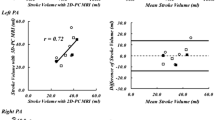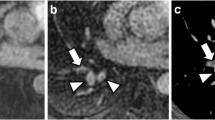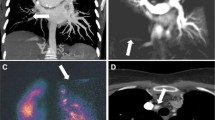Abstract
Objectives
Double inversion recovery (DIR) “black blood” MRI suppresses the signal from flowing blood, slow flowing blood causes incomplete suppression resulting in pulmonary blood flow artefact (PFA). This study examines the diagnostic utility and prognostic value of a PFA scoring system in a mixed cohort of patients with pulmonary hypertension (PH).
Methods
DIR-MRI images were reviewed for 233 patients referred with suspected PH who underwent right heart catheterisation (RHC) within 48 h of MR. The degree of PFA was visually scored in all patients from 0 to 5 (0 = absent, 1 = segmental, 2 = lobar, 3 = distal main, 4 = proximal main and 5 = trunk). Pulmonary artery (PA), aorta (Ao), and PA main branch diameters were measured from which PA/Ao ratios and mean PA branch diameters (MPAB) were calculated.
Results
PFA >1 demonstrated high sensitivity (86%) and specificity (85%) for the diagnosis PH in our mixed patient cohort. A good correlation was found with PFA and haemodynamic parameters, PVR (r = 0.70), mPAP (r = 0.65) and CI (r = −0.53). PFA predicted mortality (P = 0.005) during the mean follow-up for 19 months. PFA scoring demonstrated good inter-observer agreement (k = 0.83).
Conclusions
PFA scoring is of diagnostic and prognostic value in the assessment of patients with suspected PH. and is a predictor of mortality.
Key Points
• A simple magnetic resonance method of assessing pulmonary blood flow is presented
• This involves a qualitative scoring system of black blood pulmonary flow artefacts
• This is simple to perform and seems reproducible in pulmonary hypertension patients
• The degree of artefact correlates well with right heart catheter measurements
• Prominent pulmonary flow artefact predicts mortality in patients with pulmonary hypertension





Similar content being viewed by others
References
D’Alonzo GE, Barst RJ, Ayres SM et al (1991) Survival in patients with primary pulmonary hypertension. Results from a national prospective registry. Ann Intern Med 115(5):343–349
Humbert M, Sitbon O, Simonneau G (2004) Treatment of pulmonary arterial hypertension. N Engl J Med 351(14):1425–1436. doi:10.1056/NEJMra040291
Benza R, Biederman R, Murali S, Gupta H (2008) Role of cardiac magnetic resonance imaging in the management of patients with pulmonary arterial hypertension. J Am Coll Cardiol 52(21):1683–1692. doi:10.1016/j.jacc.2008.08.033
Alunni JP, Degano B, Arnaud C et al (2010) Cardiac MRI in pulmonary artery hypertension: correlations between morphological and functional parameters and invasive measurements. Eur Radiol 20(5):1149–1159. doi:10.1007/s00330-009-1664-3
Di Guglielmo L, Dore R, Vespro V (2005) Pulmonary hypertension: role of computed tomography and magnetic resonance imaging. Ital Heart J 6(10):846–851
Kovacs G, Reiter G, Reiter U, Rienmuller R, Peacock A, Olschewski H (2008) The emerging role of magnetic resonance imaging in the diagnosis and management of pulmonary hypertension. Respiration 76(4):458–470. doi:10.1159/000158548
Marrone G, Mamone G, Luca A et al (2010) The role of 1.5T cardiac MRI in the diagnosis, prognosis and management of pulmonary arterial hypertension. Int J Cardiovasc Imaging 26(6):665–681. doi:10.1007/s10554-010-9623-2
Song HK, Wright AC, Wolf RL, Wehrli FW (2002) Multislice double inversion pulse sequence for efficient black-blood MRI. Magn Reson Med 47(3):616–620. doi:10.1002/mrm.10094
Edelman RR, Chien D, Kim D (1991) Fast selective black blood MR imaging. Radiology 181(3):655–660
Yarnykh VL, Yuan C (2003) Multislice double inversion-recovery black-blood imaging with simultaneous slice reinversion. J Magn Reson Imaging 17(4):478–483. doi:10.1002/jmri.10278
Frank H, Globits S, Glogar D, Neuhold A, Kneussl M, Mlczoch J (1993) Detection and quantification of pulmonary artery hypertension with MR imaging: results in 23 patients. AJR Am J Roentgenol 161(1):27–31
von Schulthess GK, Fisher MR, Higgins CB (1985) Pathologic blood flow in pulmonary vascular disease as shown by gated magnetic resonance imaging. Ann Intern Med 103(3):317–323
Bouchard A, Higgins CB, Byrd BF 3rd, Amparo EG, Osaki L, Axelrod R (1985) Magnetic resonance imaging in pulmonary arterial hypertension. Am J Cardiol 56(15):938–942
White RD, Higgins CB (1989) Magnetic resonance imaging of thoracic vascular disease. J Thorac Imaging 4(2):34–50
Galie N, Hoeper MM, Humbert M et al (2009) Guidelines for the diagnosis and treatment of pulmonary hypertension. Eur Respir J 34(6):1219–1263. doi:10.1183/09031936.00139009
Ley S, Grunig E, Kiely DG, van Beek E, Wild J (2010) Computed tomography and magnetic resonance imaging of pulmonary hypertension: Pulmonary vessels and right ventricle. J Magn Reson Imaging 32(6):1313–1324. doi:10.1002/jmri.22373
Ohno Y, Hatabu H, Murase K et al (2007) Primary pulmonary hypertension: 3D dynamic perfusion MRI for quantitative analysis of regional pulmonary perfusion. AJR Am J Roentgenol 188(1):48–56. doi:10.2214/AJR.05.0135
Ohno Y, Koyama H, Nogami M et al (2008) Dynamic perfusion MRI: capability for evaluation of disease severity and progression of pulmonary arterial hypertension in patients with connective tissue disease. J Magn Reson Imaging 28(4):887–899. doi:10.1002/jmri.21550
Ley S, Mereles D, Risse F et al (2007) Quantitative 3D pulmonary MR-perfusion in patients with pulmonary arterial hypertension: correlation with invasive pressure measurements. Eur J Radiol 61(2):251–255. doi:10.1016/j.ejrad.2006.08.028
Rebergen SA, van der Wall EE, Doornbos J, de Roos A (1993) Magnetic resonance measurement of velocity and flow: technique, validation, and cardiovascular applications. Am Heart J 126(6):1439–1456
Chatzimavroudis GP, Oshinski JN, Franch RH, Walker PG, Yoganathan AP, Pettigrew RI (2001) Evaluation of the precision of magnetic resonance phase velocity mapping for blood flow measurements. J Cardiovasc Magn Reson 3(1):11–19
Sanz J, Kuschnir P, Rius T et al (2007) Pulmonary arterial hypertension: noninvasive detection with phase-contrast MR imaging. Radiology 243(1):70–79. doi:10.1148/radiol.2431060477
Tardivon AA, Mousseaux E, Brenot F et al (1994) Quantification of hemodynamics in primary pulmonary hypertension with magnetic resonance imaging. Am J Respir Crit Care Med 150(4):1075–1080
Kondo C, Caputo GR, Masui T et al (1992) Pulmonary hypertension: pulmonary flow quantification and flow profile analysis with velocity-encoded cine MR imaging. Radiology 183(3):751–758
Ley S, Mereles D, Puderbach M et al (2007) Value of MR phase-contrast flow measurements for functional assessment of pulmonary arterial hypertension. Eur Radiol 17(7):1892–1897. doi:10.1007/s00330-006-0559-9
Bradlow WM, Gatehouse PD, Hughes RL et al (2007) Assessing normal pulse wave velocity in the proximal pulmonary arteries using transit time: a feasibility, repeatability, and observer reproducibility study by cardiovascular magnetic resonance. J Magn Reson Imaging 25(5):974–981. doi:10.1002/jmri.20888
Saba TS, Foster J, Cockburn M, Cowan M, Peacock AJ (2002) Ventricular mass index using magnetic resonance imaging accurately estimates pulmonary artery pressure. Eur Respir J 20(6):1519–1524
Hagger D, Condliffe R, Woodhouse N et al (2009) Ventricular mass index correlates with pulmonary artery pressure and predicts survival in suspected systemic sclerosis-associated pulmonary arterial hypertension. Rheumatology (Oxford) 48(9):1137–1142. doi:10.1093/rheumatology/kep187
Acknowledgements
A.J.S., H.M., R.C., C.E., J.M.W. and D.G.K. received funding from the National Institute for Health Research (NIHR) via its Biomedical Research Units funding scheme. H.M. and J.M.W. are also funded by the Engineering and Physical Sciences Research Council (EPSRC). D.C. receives funding from Bayer Schering, S.R. from Pfizer and J.H. from Actelion Pharmaceuticals.
Author information
Authors and Affiliations
Corresponding author
Rights and permissions
About this article
Cite this article
Swift, A.J., Rajaram, S., Marshall, H. et al. Black blood MRI has diagnostic and prognostic value in the assessment of patients with pulmonary hypertension. Eur Radiol 22, 695–702 (2012). https://doi.org/10.1007/s00330-011-2306-0
Received:
Revised:
Accepted:
Published:
Issue Date:
DOI: https://doi.org/10.1007/s00330-011-2306-0




